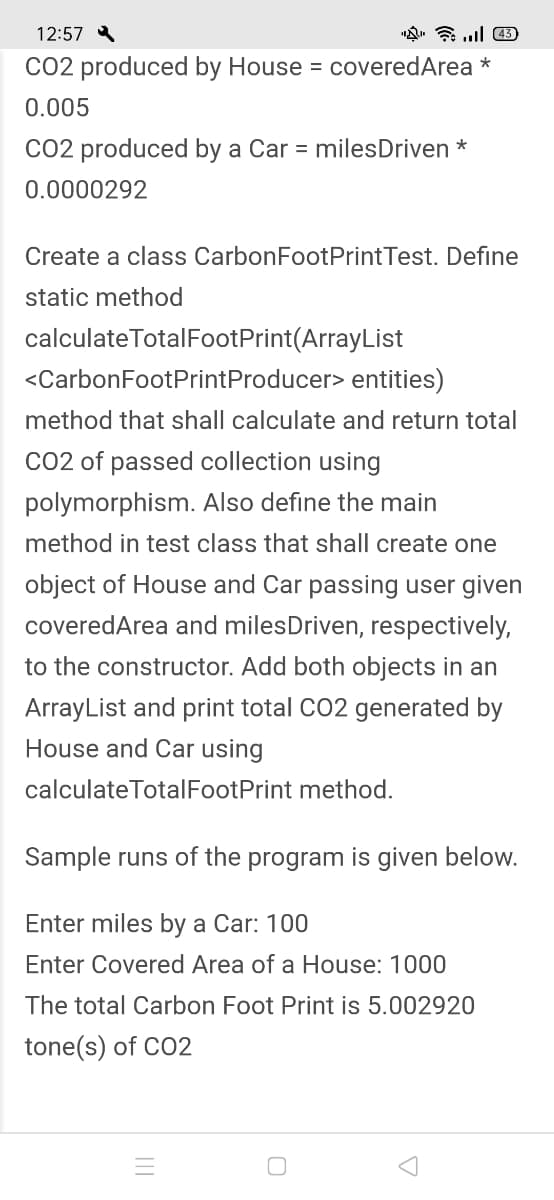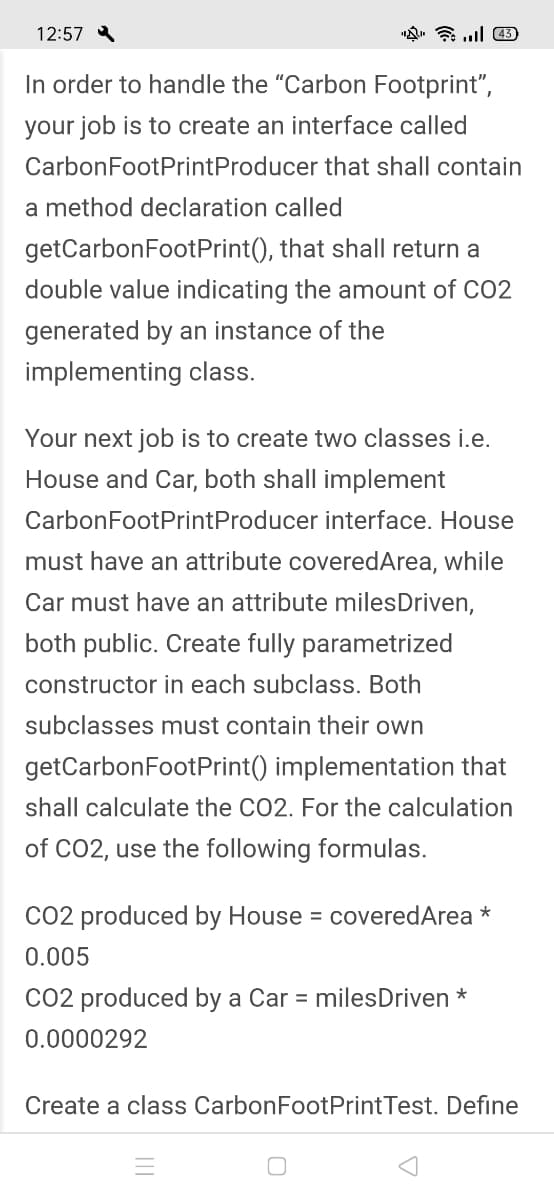Solve this in java oop. In order to handle the “Carbon Footprint”, your job is to create an interface called CarbonFootPrintProducer that shall contain a method declaration called getCarbonFootPrint(), that shall return a double value indicating the amount of CO2 generated by an instance of the implementing class. Your next job is to create two classes i.e. House and Car, both shall implement CarbonFootPrintProducer interface. House must have an attribute coveredArea, while Car must have an attribute milesDriven, both public. Create fully parametrized constructor in each subclass. Both subclasses must contain their own getCarbonFootPrint() implementation that shall calculate the CO2. For the calculation of CO2, use the following formulas. CO2 produced by House = coveredArea * 0.005 CO2 produced by a Car = milesDriven * 0.0000292 Create a class CarbonFootPrintTest. Define static method calculateTotalFootPrint(ArrayList entities) method that shall calculate and return total CO2 of passed collection using polymorphism. Also define the main method in test class that shall create one object of House and Car passing user given coveredArea and milesDriven, respectively, to the constructor. Add both objects in an ArrayList and print total CO2 generated by House and Car using calculateTotalFootPrint method. Sample runs of the program is given below. Enter miles by a Car: 100 Enter Covered Area of a House: 1000 The total Carbon Foot Print is 5.002920 tone(s) of CO2
Solve this in java oop. In order to handle the “Carbon Footprint”, your job is to create an interface called CarbonFootPrintProducer that shall contain a method declaration called getCarbonFootPrint(), that shall return a double value indicating the amount of CO2 generated by an instance of the implementing class. Your next job is to create two classes i.e. House and Car, both shall implement CarbonFootPrintProducer interface. House must have an attribute coveredArea, while Car must have an attribute milesDriven, both public. Create fully parametrized constructor in each subclass. Both subclasses must contain their own getCarbonFootPrint() implementation that shall calculate the CO2. For the calculation of CO2, use the following formulas. CO2 produced by House = coveredArea * 0.005 CO2 produced by a Car = milesDriven * 0.0000292 Create a class CarbonFootPrintTest. Define static method calculateTotalFootPrint(ArrayList entities) method that shall calculate and return total CO2 of passed collection using polymorphism. Also define the main method in test class that shall create one object of House and Car passing user given coveredArea and milesDriven, respectively, to the constructor. Add both objects in an ArrayList and print total CO2 generated by House and Car using calculateTotalFootPrint method. Sample runs of the program is given below. Enter miles by a Car: 100 Enter Covered Area of a House: 1000 The total Carbon Foot Print is 5.002920 tone(s) of CO2
Database System Concepts
7th Edition
ISBN:9780078022159
Author:Abraham Silberschatz Professor, Henry F. Korth, S. Sudarshan
Publisher:Abraham Silberschatz Professor, Henry F. Korth, S. Sudarshan
Chapter1: Introduction
Section: Chapter Questions
Problem 1PE
Related questions
Question
100%
Solve this in java oop.
In order to handle the “Carbon Footprint”, your job is to create an interface called CarbonFootPrintProducer that shall contain a method declaration called getCarbonFootPrint(), that shall return a double value indicating the amount of CO2 generated by an instance of the implementing class.
Your next job is to create two classes i.e. House and Car, both shall implement CarbonFootPrintProducer interface. House must have an attribute coveredArea, while Car must have an attribute milesDriven, both public. Create fully parametrized constructor in each subclass. Both subclasses must contain their own getCarbonFootPrint() implementation that shall calculate the CO2. For the calculation of CO2, use the following formulas.
CO2 produced by House = coveredArea * 0.005
CO2 produced by a Car = milesDriven * 0.0000292
Create a class CarbonFootPrintTest. Define static method calculateTotalFootPrint(ArrayList entities) method that shall calculate and return total CO2 of passed collection using polymorphism. Also define the main method in test class that shall create one object of House and Car passing user given coveredArea and milesDriven, respectively, to the constructor. Add both objects in an ArrayList and print total CO2 generated by House and Car using calculateTotalFootPrint method.
Sample runs of the program is given below.
Enter miles by a Car: 100
Enter Covered Area of a House: 1000
The total Carbon Foot Print is 5.002920 tone(s) of CO2

Transcribed Image Text:12:57
CO2 produced by House = coveredArea *
0.005
CO2 produced by a Car = milesDriven *
0.0000292
Create a class CarbonFootPrintTest. Define
static method
calculateTotalFootPrint(ArrayList
<CarbonFootPrintProducer> entities)
method that shall calculate and return total
CO2 of passed collection using
polymorphism. Also define the main
method in test class that shall create one
object of House and Car passing user given
coveredArea and milesDriven, respectively,
to the constructor. Add both objects in an
ArrayList and print total CO2 generated by
House and Car using
calculateTotalFootPrint method.
Sample runs of the program is given below.
Enter miles by a Car: 100
Enter Covered Area of a House: 1000
The total Carbon Foot Print is 5.002920
tone(s) of CO2

Transcribed Image Text:12:57
In order to handle the "Carbon Footprint",
your job is to create an interface called
CarbonFootPrintProducer that shall contain
a method declaration called
getCarbonFootPrint(), that shall return a
double value indicating the amount of CO2
generated by an instance of the
implementing class.
Your next job is to create two classes i.e.
House and Car, both shall implement
CarbonFootPrintProducer interface. House
must have an attribute coveredArea, while
Car must have an attribute milesDriven,
both public. Create fully parametrized
constructor in each subclass. Both
subclasses must contain their own
getCarbonFootPrint() implementation that
shall calculate the CO2. For the calculation
of CO2, use the following formulas.
CO2 produced by House = coveredArea *
0.005
CO2 produced by a Car = milesDriven *
0.0000292
Create a class CarbonFootPrintTest. Define
Expert Solution
This question has been solved!
Explore an expertly crafted, step-by-step solution for a thorough understanding of key concepts.
This is a popular solution!
Trending now
This is a popular solution!
Step by step
Solved in 4 steps with 1 images

Knowledge Booster
Learn more about
Need a deep-dive on the concept behind this application? Look no further. Learn more about this topic, computer-science and related others by exploring similar questions and additional content below.Recommended textbooks for you

Database System Concepts
Computer Science
ISBN:
9780078022159
Author:
Abraham Silberschatz Professor, Henry F. Korth, S. Sudarshan
Publisher:
McGraw-Hill Education

Starting Out with Python (4th Edition)
Computer Science
ISBN:
9780134444321
Author:
Tony Gaddis
Publisher:
PEARSON

Digital Fundamentals (11th Edition)
Computer Science
ISBN:
9780132737968
Author:
Thomas L. Floyd
Publisher:
PEARSON

Database System Concepts
Computer Science
ISBN:
9780078022159
Author:
Abraham Silberschatz Professor, Henry F. Korth, S. Sudarshan
Publisher:
McGraw-Hill Education

Starting Out with Python (4th Edition)
Computer Science
ISBN:
9780134444321
Author:
Tony Gaddis
Publisher:
PEARSON

Digital Fundamentals (11th Edition)
Computer Science
ISBN:
9780132737968
Author:
Thomas L. Floyd
Publisher:
PEARSON

C How to Program (8th Edition)
Computer Science
ISBN:
9780133976892
Author:
Paul J. Deitel, Harvey Deitel
Publisher:
PEARSON

Database Systems: Design, Implementation, & Manag…
Computer Science
ISBN:
9781337627900
Author:
Carlos Coronel, Steven Morris
Publisher:
Cengage Learning

Programmable Logic Controllers
Computer Science
ISBN:
9780073373843
Author:
Frank D. Petruzella
Publisher:
McGraw-Hill Education